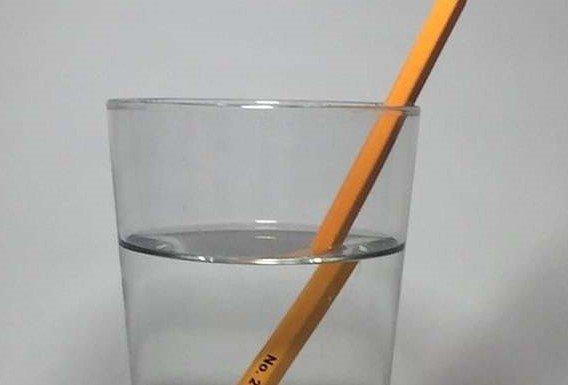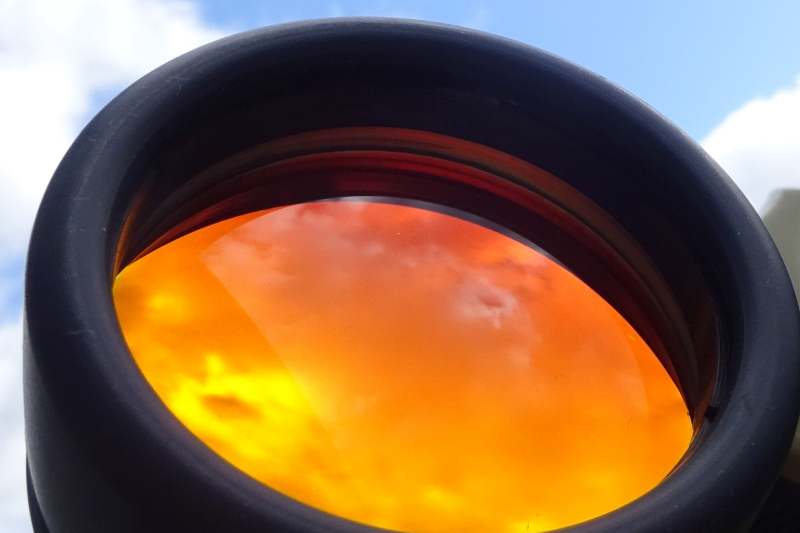 Every time when a beam of light travels from one medium into another the beam of light is bent (refracted). An observation you have probably wondered about as a child when putting a straw in a glass of water. When light is traveling through an optical instrument the optical glass of binoculars reflects, refract, and absorbs some of the light. This alteration of the light can affect the projected images’ brightness, clarity, and contrast. In addition, ghosting may occur due to stray light. The aim of optical designers is therefore to minimize the amount of reflected light, thus maximizing the Transmission. This is achieved by using quality glass and applying optical coatings to the glass surfaces.
Every time when a beam of light travels from one medium into another the beam of light is bent (refracted). An observation you have probably wondered about as a child when putting a straw in a glass of water. When light is traveling through an optical instrument the optical glass of binoculars reflects, refract, and absorbs some of the light. This alteration of the light can affect the projected images’ brightness, clarity, and contrast. In addition, ghosting may occur due to stray light. The aim of optical designers is therefore to minimize the amount of reflected light, thus maximizing the Transmission. This is achieved by using quality glass and applying optical coatings to the glass surfaces.
What are Binoculars Lens Coatings for?
The binoculars lens coating is applied to reduce the reflection of light at the glass surface and to allow more light to pass through the lens. The lens coatings effectively increase transmission.
This can be observed in an increase in the brightness, contrast, and color fidelity of the projected images.
The high-quality coating of optical glass surfaces is not only responsible for a considerable increase in optical performance but unfortunately also a factor that can greatly push up the cost of good binoculars.
What Happens when light travels through glass?
 Even if a glass looks completely transparent to our eye at first glance, for a beam of light it is not completely transparent. There are molecules and atoms the light has to find its way around. So part of the incident light is absorbed; some is reflected. Binoculars consist of numerous lenses and prisms, and thus the light must pass through many glass surfaces on its way to the eye of the observer.
Even if a glass looks completely transparent to our eye at first glance, for a beam of light it is not completely transparent. There are molecules and atoms the light has to find its way around. So part of the incident light is absorbed; some is reflected. Binoculars consist of numerous lenses and prisms, and thus the light must pass through many glass surfaces on its way to the eye of the observer.
During every transition from one medium to another, some of the incident light intensity is lost. Repeated reflections increase scattered light, which together with useful light can cause disturbing light spots (reflections), Gaussian blur, reduces the contrast of the image, and add a diffuse haze.
Without anti-reflective coatings, binoculars with multiple lenses and prisms would be virtually impossible to use.
What is the benefit of optical Coatings?
The choice of glass types and the type of coating of lenses and prisms strongly influence the light transmission and contrast. Contrast refers to the difference in luminance between adjoining light and dark areas. High contrast is subjectively perceived as more brilliant and seemingly sharper than low contrast but can be at the expense of color fidelity. High-quality glass types and coatings help to reduce unwanted stray light, backlashes, and color fringing.
Depending on the intended use of the binoculars, however, different coatings may be preferred. For example in hunting binoculars, which are often used in the twilight phase, the emphasis is placed on better light transmission in the wavelength of the twilight light. In birdwatching binoculars, the coatings may be optimized for maximum color fidelity.
How to coat optical instruments?
Optical coating or antireflection coating of glass is achieved by “vapor deposition” of metal oxides and fluorides on lenses and prisms. These substances have a low refractive index and thus reduce the reflection of light on the glass surfaces and increase light transmission.
Single coatings improve the transmission in one part of the light spectrum. Multiple coatings reduce the reflection on the glass surfaces over a large part or even the entire visible wavelength range.
The various coatings influence each other, which makes the process complex and expensive, but the reward is a very high light transmission and sharp and crisp images. The best binoculars always have fully multi- and phase correcting coatings.
How to tell if lenses are coated?
Coated lenses are easy to tell. Simply look into the lens with a light source in your back and slowly move the binoculars. If you see a blue color shine appear, the lens is coated. If you see a green shine with a hint of other colors, the lens is double-coated or multicoated.
Types of Binoculars Lens Coating
There are different types of coating with regard to the coating material, the type of glass, and the effort involved in the production. It can be differentiated between simple single coating, fully coated, multi-coated, and special anti-reflective phase coating.
Coated
A thin, one-layer anti-reflective coating applied to one side of at least one or more lens surfaces.
Fully coated
One coating on both sides of the lenses and on the prism.
Multi-coated
Several coatings with different Refractive indices to cover a wider range of wavelength on one or more of the lens surfaces.
Fully multi-coated
Reflected in the price and typical for high-end optics are multiple coatings on all lens surfaces and prisms. Multiple layers with different refractive indices reduce reflections and refraction over the whole visible wavelength of the spectrum.
Phase coating
A more complex kind of binoculars coating is phase coating the prims. In a roof prism, part of the light exits the glass polarised and with a slight phase shift. This is due to the optical construction of the prism and can reduce the brightness and the contrast of the projected image. Phase coating the surface of the prism reduces this effect.
Is it worth spending on binoculars lens coating?
When light passes from one medium to another medium, part of the incident light is reflected. This leads to a loss of light. The loss adds up according to the number of transmissions in the optical system. To minimize these losses, the glass surfaces must be coated. Depending on the glass used and the complexity of the coating, a transmission of up to 99.9% can be achieved.
Antireflective coatings are indispensable to maximize light transmission binoculars, telescopes, or microscopes. Coatings reduce the reflection loss on a glass surface and minimize the refraction of the light beam in an optical system to increase the brightness of the projected image.
Learn more about Optical Coatings:
https://www.schott.com/en-us/……optical-coatings
https://www.edmundoptics.com/knowledge-center…optical-coatings/



